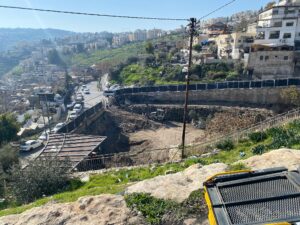As the Jim Joseph Foundation works toward developing “dynamic, pioneering leaders and educators,” the Foundation wants to learn about the most effective professional development experiences. To this end, about a year and a half ago, the Foundation launched an initiative to test new models of connection, learning, and leadership development in cohort settings for mid-career professionals within the Jewish community. The Foundation hired Heather Wolfson, along with Seth Linden and Gamal J. Palmer, to help guide this work (Rachel Brodie, z’’l, was also a key partner in the first phase of this work). Together, we have been testing cohort models to understand what makes these experiences so powerful and which design elements contribute to their success: increasing retention and supporting career growth and feelings of connectedness and belonging. Our ultimate aim is to understand how we might greatly expand and democratize–to make accessible and more affordable–the “cohort-based professional development experiences in the Jewish communal ecosystem, to support and nourish the Jewish educators and leaders who are the backbone of Jewish communal life.”
The Foundation also wanted these cohort-based professional development offerings to be different from other experiences that exist. With that in mind, the cohort members in this initiative self-organize around who is in the group and the content they discuss. Unlike more selective professional development programs with fewer participants, this initiative envisions a scalable model over several years with thousands of participants benefiting because they help co-design and co-create the experiences that are both enriching and cost-efficient. In this model, the Foundation provides administrative support and financial resources, and a framework for deciding the purpose, participants and content. The groups can bring in a facilitator or outside speakers without the additional burden of scheduling and leading the PD themselves.
After supporting twelve cohorts for different targeted audiences, we want to share key learnings from our experience and from independent evaluation conducted by Tobin Belzer, PhD. These learnings might help others who are running or are considering running cohort programs to develop future leaders. To facilitate our learning with this early round of experimentation, the initial cohorts served professionals representing a wide range of roles and interests. A few examples include event planners who are responsible for the execution of large-scale convenings for Jewish nonprofits, BIPOC professionals who lead DEI efforts within Jewish organizations, and practitioners of cohort-based experiences.
Here’s what we learned:
People crave low pressure connections and micro-communities.
We launched this initiative coming out of the height of the pandemic. People desperately want connections to other people with whom they share professional and personal experiences. Our cohort sessions were fairly informal, which reflected the desires of the groups. We had some guest speakers, shared facilitation and leadership roles, and plenty of time simply for talking and reflecting. This low pressure tenor can be accomplished both in-person and virtually; people appreciated that sessions consistently adhered to this structure. While many often view the mental health crisis affecting young adults and teens, feelings of isolation and anxiety are prevalent among all demographics—especially those professionals supporting young adults and teens. These cohorts were, as the initiative’s first documentation report details, “supportive containers.” One participant shared, “This group made me feel more confident in my position—I now have a place to better understand industry norms, brainstorm, network and bring back real data to my organization.” Having a micro-community of peers to share challenges and successes strengthens feelings of connectedness, which is one factor in sustaining positive mental health.
People want to feel seen, heard, and valued. These micro-investments do that.
Many nonprofit professionals feel they lack professional development opportunities and room for growth at their organizations. Only a select few are in the prestigious fellowship programs that are designed to help professionals learn new skills and build their networks. When we launched the initiative, aside from the first cohorts that the Foundation identified, we solicited proposals from professionals in the field of Jewish education to ask what leadership development cohorts they wanted to design and participate in. We hosted a webinar for 50+ people, and fielded nearly 20 applications for the five cohorts that we chose to participate with us in this early phase of learning. Being asked what learning experiences they would find most impactful and helpful, and with whom—and then seeing that take shape in a cohort-based experience—was a powerful validation of their work and worth. As one participant shared during the evaluation process, “I really appreciated having the support, knowledge and guidance of my colleagues.”
People seek a range of modalities to access learning.
The settings and ways in which learning occurs should be dynamic and reflect learning for the whole person. People expect nothing less. Our first cohorts are now thinking about how they will continue learning together with guest speakers and retreats. Other modalities we have offered or facilitated include self-care, wellness activities, and book exchanges among cohort members. We found that people want both guidance and autonomy; they want to be empowered to lead and teach in certain areas. Cohort members have also selected conferences that they want to attend with each other. The modalities should be varied and enable people to find the learning opportunities that best suit them.
The number of cohort members matters.
This is key. After different scenarios and some trial and error, we found that having too many people in a cohort poses challenges and makes it more difficult for the group to really bond and feel connected. Somewhere between six and twelve people seems optimal. However, you also need to account for cohort members who do not attend every session. If you accept 15 people, ten might show up regularly. Setting attendance parameters in advance can help to avoid this issue. Also, depending on the number of people, in-person or virtual offers different benefits and challenges—from scheduling conflicts to sharing information.
Cohort-based programs should have clear goals and outcomes.
Program participants want to know the purpose behind the programs in which they participate, including the long-term goals and desired outcomes. The Foundation, for example, launched this to “nourish” each participant, but the long-term goal is to increase the efficacy and retention of professionals in the Jewish nonprofit sector. The evaluation shows that this experience expanded the participants’ understanding of the Jewish organizational landscape and helped them recognize there is a place for themselves in the Jewish communal sector beyond their current position.
Throughout the program, cohort members asked us good, pointed questions about why we were running this initiative. The latest evaluation shows their desire to have clear answers to these questions. Their time is valuable and they wanted to know being in this program was time well spent—both regarding what they would learn and the bigger-picture aspiration of this endeavor.
We know there is still much to learn about the recruitment, structure, content, modalities, and more of these cohort programs. We also express gratitude to the participants and all other professionals who submitted proposals. They were, and are, part of this learning journey. Moving forward, we will continue to support existing groups, explore working with network organizations as partners, and develop plans to go beyond this pilot phase, making this opportunity available to more Jewish professionals across the field.
More background information and learnings from the Cohort-Based Professional Development Experiences Initiative can be found in the initial October 2022 documentation report by Rosov Consulting and the May 2023 Phase II evaluation report by Dr. Tobin Belzer.
Heather Wolfson leads Maven Leadership Consulting, Seth Linden leads Gather Consulting, and Gamal J. Palmer leads Conscious Builders. Jenna Hanauer is a Program Officer at the Jim Joseph Foundation.
 These reports and tools are used by communities, foundations, and individual schools to optimize efficiency and maximize potential, often making a direct impact on decision-making. In one case, a school leader who was struggling to recruit new teachers accessed data from DASL (Data and Analysis for School Leadership), Prizmah’s financial and operational benchmarking tool, and realized that her school’s compensation structure put them on the very low end in the marketplace. Recognizing the impact this had on their ability to recruit talented educators, this leader and her board made the decision to increase teacher salaries.
These reports and tools are used by communities, foundations, and individual schools to optimize efficiency and maximize potential, often making a direct impact on decision-making. In one case, a school leader who was struggling to recruit new teachers accessed data from DASL (Data and Analysis for School Leadership), Prizmah’s financial and operational benchmarking tool, and realized that her school’s compensation structure put them on the very low end in the marketplace. Recognizing the impact this had on their ability to recruit talented educators, this leader and her board made the decision to increase teacher salaries.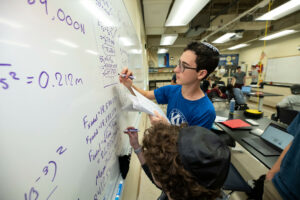 champions the use of data by schools, the organization itself make research and data a critical part of its operations.
champions the use of data by schools, the organization itself make research and data a critical part of its operations.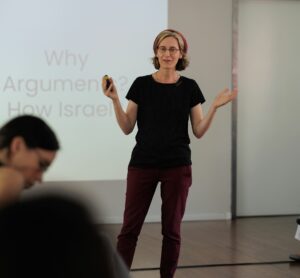 meaningful ways. Its book
meaningful ways. Its book 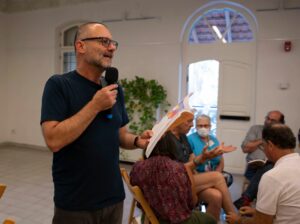 FSA offers many ways for educators and leaders to learn about this approach to education. A 90-minute introductory workshop models the FSA framework and tools, and in-depth courses for professionals provide a deeper mastery of engaging with contentious issues. FSA’s open
FSA offers many ways for educators and leaders to learn about this approach to education. A 90-minute introductory workshop models the FSA framework and tools, and in-depth courses for professionals provide a deeper mastery of engaging with contentious issues. FSA’s open 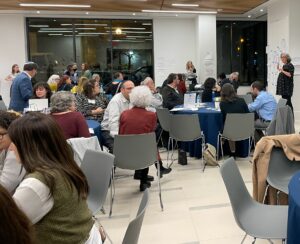 the 60 program directors at this convening saw themselves as individuals within a professional field—not in silos focusing only on their particular audience or setting. With this mindset, their learning and knowledge sharing covered more topics and focused on more audiences. And any successes each person has is much more likely to impact one of their peers. The group of participants spent two days hearing about research findings (studies both inside the Jewish education arena and outside), asking questions to gain clarity and understanding, breaking into small groups—sometimes with peers they collaborated with previously and sometimes with peers they never thought to consult—and brainstorming how to apply their new learning to improve their programs.
the 60 program directors at this convening saw themselves as individuals within a professional field—not in silos focusing only on their particular audience or setting. With this mindset, their learning and knowledge sharing covered more topics and focused on more audiences. And any successes each person has is much more likely to impact one of their peers. The group of participants spent two days hearing about research findings (studies both inside the Jewish education arena and outside), asking questions to gain clarity and understanding, breaking into small groups—sometimes with peers they collaborated with previously and sometimes with peers they never thought to consult—and brainstorming how to apply their new learning to improve their programs.